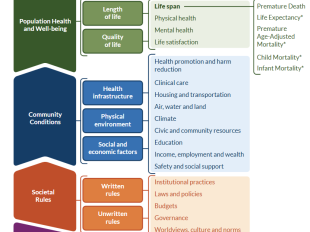A Blueprint to Help Communities Achieve Health Equity for All Children and Families: A Q & A with Kate Kingery
Kate Kingery, CHR&R’s deputy director of community transformation, discusses how and why she became involved in the development of ChangeLab Solutions’ A Blueprint for Changemakers: Achieving Health Equity Through Law & Policy, which presents legal strategies and best practices to help policymakers, practitioners, and communities improve health for everyone.
Tell me a little bit about how you got involved with ChangeLab Solutions’ Blueprint for Changemakers and why you decided to serve on its advisory committee.
When I first met Marice Ashe, ChangeLab Solutions’ founder and CEO, it was a real meeting of the minds. We are both strong champions for kids and recognize the important role public health can play to improve the well-being of children and their families.
County Health Rankings & Roadmaps focuses on improving community health outcomes and advancing equity. So, I welcomed the invitation to be part of ChangeLab Solutions’ Blueprint for Changemakers Advisory Committee. Knowing the Blueprint would help lift up health equity and the policies and programs that can help improve the lives of children and families, I saw strong alignment in our work.
What stood out to you about health equity in the Blueprint?
What first resonated with me was the emphasis on the five structural drivers of inequity: structural discrimination; disparities in opportunity; power; income inequality and poverty; and governance that limit meaningful participation. They help provide an accessible framework for changemakers to understand why inequities exist, how they affect people’s lives, and ways law and policy can be effective tools to create opportunities for everyone to live their healthiest lives.
The United States has a long history of racism and discriminatory policies that have limited opportunities, especially for people of color. Many people are familiar with the federal policy known as “redlining” that denied or limited loans to Black neighborhoods while simultaneously subsidizing White suburbs. Decades of research has shown that residential segregation is a fundamental cause of health disparities.
In the 2019 County Health Rankings we highlight data that show how these kinds of discriminatory policies affect people. For example, in large urban and smaller metro counties, 1 in 4 Black households pay more than half their incomes for housing, compared to 1 in 10 White households. Homeownership is a significant pathway to building financial equity and generational wealth. However, Black homeownership rates fall far below that of White homeownership and it’s been this way for more than 50 years since the passage of the federal Fair Housing Act. Places with opportunity and access to secure, affordable housing are also places where there are fewer children in poverty, more families who have enough to eat, and residents living long and well, which helps which illustrate some of the ways that housing is a foundation for good health.
The Blueprint clearly outlines laws and policies that communities can focus on to create opportunities for good health and advance equity such as: ensure fair employment for all; improve wages for poor and low-income individuals; increase access to quality education, transportation, and health care; support inclusionary zoning; and enforce fair housing laws. It’s important that communities learn about the needs and priorities of residents and identify what will work in their local context to reduce poverty and build wealth that lasts for generations to come.
What did you learn about law and policy as a way to promote health equity through this process?
Using law and policy is an effective way to address structural equity for groups of people. Adopting an approach like Health in All Policies helps combine health, equity and sustainability considerations into decision making across sectors and policy areas.
Through my work with the Blueprint Advisory Committee, I also learned more about ChangeLab Solutions’ work on preemption—a legal mechanism where higher levels of government can invalidate laws and policies at lower levels, such as state over county—and the effect it can have on public health, such as local control over zoning and land use, paid sick days or family leave, and minimum wage increases. It’s an important factor for communities to consider when advocating for policies to address health equity. ChangeLab is a leader in this area and has many resources available for communities who want to learn more.
Do you have examples of communities working to address health equity?
The RWJF Culture of Health Prize is a great place for examples of communities addressing health equity. The Prize aims to recognize communities that are working to create conditions that give everyone a fair and just opportunity to reach their best possible health as well as commit to sustainable systems’ changes and policy-oriented solutions.
For example, Chelsea, Massachusetts, a 2017 Culture of Health Prize winner, is rolling out forward-thinking policies to tackle a variety of issues including substance abuse, pollution, obesity, homelessness, and violence. But it is also a community comprising many new immigrants. Local leaders have implemented sanctuary city protections for those immigrants who are undocumented, but from a more long-term standpoint, they want to ensure there is equity and opportunity for everyone living in Chelsea and the Blueprint can help them achieve this goal.
In San Antonio, Texas, also a 2018 RWJF Culture of Health Prize winner, community residents led initiatives to approve funding for city-wide, all-day pre-K and to expand internet access for public housing residents. City leaders have focused on increasing equity by implementing policies through the Office of Equity and prioritizing opportunities for historically marginalized neighborhoods and populations in the city’s budget.
These examples reflect the kinds of policies outlined in the Blueprint that address the structural drivers of inequity. In addition, CHR&R has a collection of more than 400 evidence-informed strategies to address the multiple drivers of health and equity in our What Works for Health resource on our website.
Many communities would find the Blueprint valuable, including Prize communities. As we always say, like the Blueprint, the Prize is part of a journey, not a destination.
How can communities use the Blueprint for Changemakers?
We focus on policy, systems and environmental changes as a pathway to improve health and the Blueprint offers real, tangible approaches for how to do that. Building a movement to improve health equity means supporting communities in their journey to reach the policy goals they’ve identified. In order to do this, it is important to engage community residents in authentic and meaningful ways to give voice and agency to their interests and needs, particularly residents experiencing poor health outcomes. To address the drivers of health and equity, it’s crucial to understand the root causes of inequities and barriers to opportunity.
We recognize that no matter where a community is on their journey to advance health equity, resources like ChangeLab Solutions’ Blueprint for Changemakers offers communities invaluable grounding. CHR&R’s Action Center serves as a helpful companion to the Blueprint, providing step-by-step guidance to empower residents and community leaders to bring these strategies to life.
Addressing health equity is critical to having thriving communities and a vibrant nation where everyone has the opportunity to live their healthiest life.



